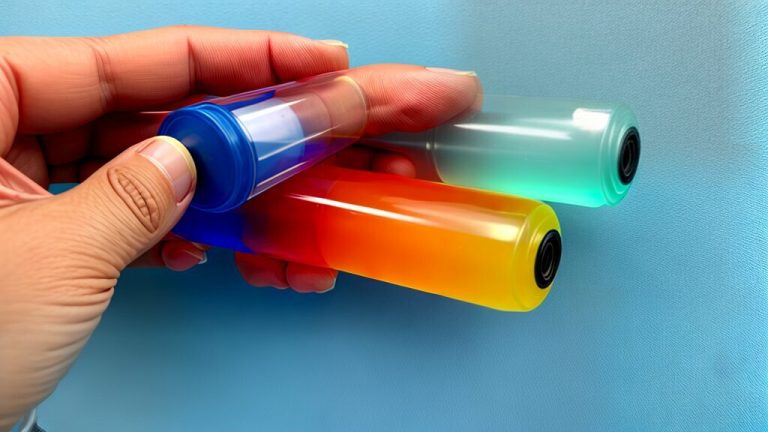What is Serum Osmolality? Understanding its Importance & Role
When it comes to staying adequately hydrated, understanding serum osmolality is crucial. Serum osmolality measures the concentration of solutes in the serum, indicating the body’s ability to maintain optimal fluid levels.
In simple terms, serum osmolality measures the body’s hydration status. Variations from the normal range can indicate dehydration or overhydration, both of which can have detrimental effects on overall health.
Key Takeaways:
- Serum osmolality measures the concentration of solutes in the serum.
- Variations in serum osmolality can indicate dehydration or overhydration.
- Serum osmolality is crucial in maintaining optimal fluid levels and overall health.
The Science Behind Serum Osmolality
Serum osmolality measures the concentration of solutes in the serum or the liquid part of the blood. It reflects the body’s ability to maintain optimal fluid levels and is an essential indicator of hydration status.
The osmolality of the serum depends on the number of particles dissolved in it, including electrolytes; potassium, sodium, and chloride, as well as glucose and other solutes.
Measuring serum osmolality is essential in diagnosing and monitoring various medical conditions. It is beneficial in evaluating the body’s response to dehydration or fluid overload and detecting electrolyte imbalances.
The usual range of serum osmolality is between 275 and 295 milliosmoles per kilogram of water (mOsm/kg H2O). Values outside this range may indicate an imbalance in the body’s hydration status and require further evaluation by a healthcare professional.
Serum osmolality is crucial in regulating fluid balance and maintaining overall health and well-being.
Serum Osmolality Levels and Normal Range
The normal range for serum osmolality ranges from 275 to 295 milliosmoles per kilogram of water (mOsm/kg H2O). This range can vary mildly depending on the laboratory’s specific measurement methods.
Values lower than the normal range may indicate overhydration or excessive water consumption. Conversely, values above the normal range may indicate dehydration or excess solute concentration.
| Condition | Serum Osmolality Levels |
|---|---|
| Hyponatremia | <275 mOsm/kg H2O |
| Normal | 275-295 mOsm/kg H2O |
| Most common range for serum osmolality | 280-295 mOsm/kg H2O |
| Hypernatremia | >295 mOsm/kg H2O |
It’s important to note that age, sex, and overall health status can affect serum osmolality levels and may cause variations from the normal range.
The Importance of Serum Osmolality
Serum osmolality is crucial in regulating the body’s fluid balance, making it an essential aspect of overall health. The concentration of solutes in the serum determines osmolality, which in turn reflects the body’s ability to maintain optimal fluid levels. Any imbalance in serum osmolality can lead to health complications.
The body maintains a delicate balance of fluids and electrolytes; serum osmolality is a marker of this balance. When serum osmolality is within the normal range, the body is adequately hydrated and can maintain fluid and electrolyte balance. However, an imbalance in serum osmolality can have severe consequences for the body.
High serum osmolality can lead to dehydration, which might cause symptoms like thirst, dry mouth, and skin, and even result in seizures or coma. In contrast, low serum osmolality can indicate overhydration, which can cause symptoms such as vomiting, nausea, and confusion.
Furthermore, imbalances in serum osmolality can also indicate underlying medical conditions such as diabetes insipidus, kidney disease, or alcohol poisoning, which can have severe consequences if not promptly diagnosed and treated.
Therefore, maintaining optimal serum osmolality is vital for overall health. It can be achieved through proper hydration, a balanced diet, and lifestyle choices that promote electrolyte balance and fluid regulation. This may involve drinking adequate amounts of water, avoiding over consumption of alcohol and caffeine, and consuming foods rich in electrolytes such as potassium and magnesium.
Overall, monitoring and maintaining optimal serum osmolality is essential for good health, and any imbalances should be promptly addressed to prevent further complications.
Understanding the Serum Osmolality Test
The serum osmolality test is a laboratory test that measures the concentration of solutes in the serum or the liquid portion of the blood. It is a simple blood test typically ordered by a healthcare provider to assess the body’s hydration status and electrolyte balance.
The test is conducted by drawing a blood sample from one of the vein present in the arm, which is later sent to a laboratory for analysis. The lab technician measures the serum’s osmolality using an osmometer, which calculates the number of particles per fluid unit (usually measured in milliosmoles per kilogram of water or mOsm/kg).
The serum osmolality test is helpful in diagnosing several medical conditions, such as diabetes insipidus, hyponatremia, and hypernatremia. Changes in serum osmolality levels can indicate imbalances in the body’s hydration status, electrolyte levels, or kidney function.
Factors Affecting Serum Osmolality Test Results
Several factors can affect the accuracy of serum osmolality test results. These include:
- Dehydration or overhydration before the test
- Administration of intravenous fluids or medications that alter electrolyte balance
- Presence of higher level of lipids or proteins in the serum
- Technical errors in the laboratory during sample collection or analysis
It’s essential to follow any pre-test instructions your healthcare provider provides to ensure accurate test results.
Did You Know? The serum osmolality test is different from the urine osmolality test, that measures the concentration of solutes in the urine. Your healthcare provider may order both tests to get a complete picture of your body’s hydration status.
High Serum Osmolality: Causes and Implications
High serum osmolality occurs when the concentration of solutes in the serum is too high, indicating a lack of water in the body. This can further lead to dehydration and other health complications if left untreated.
Several medical conditions can cause high serum osmolality, including diabetes insipidus, hypernatremia, and hyperglycemia. In addition, excessive sweating, vomiting, and diarrhea can also contribute to elevated serum osmolality levels.
Implications of high serum osmolality include increased thirst, dry mouth, fatigue, decreased urine output, confusion, and even seizures. Left untreated might lead to kidney damage and other severe health complications.
It is important to seek medical attention if you experience any symptoms associated with high serum osmolality. A medical professional will diagnose the underlying causes of the elevated levels and recommend the appropriate treatment.
Diabetes Insipidus
One common condition that can lead to high serum osmolality is diabetes insipidus. This disorder affects the body’s ability to regulate fluid levels, often caused by damage to the pituitary gland or kidneys.
When the body is unable to produce enough antidiuretic hormone (ADH), it results in excessive urine output and subsequent dehydration. This leads to a concentration of solutes in the serum, resulting in high serum osmolality.
Treatment for diabetes insipidus typically involves replacing the missing ADH hormone and increasing fluid intake to maintain hydration levels.
Low Serum Osmolality: Causes and Implications
Low serum osmolality refers to a drop in the concentration of solutes in the serum below the normal range. This can occur due to several other factors, including excessive fluid intake, kidney dysfunction, or hormonal imbalances.
One of the common causes of low serum osmolality is overhydration or water intoxication. Drinking excessive amounts of water without balancing it with electrolytes can dilute the serum and lower osmolality levels. This condition can lead to hyponatremia, a dangerous electrolyte imbalance that can cause headaches, nausea, seizures, and even coma.
Other medical conditions that can cause low serum osmolality include renal failure, adrenal insufficiency, and certain medications. Endocrine disorders such as hypothyroidism and SIADH (syndrome of inappropriate antidiuretic hormone secretion) can also affect osmolality levels.
Low serum osmolality can have severe implications for the body. It can upset the delicate balance of fluid and electrolytes, leading to dehydration, swelling of cells, and other health issues. In serious cases, it can even be life-threatening.
It is essential to promptly identify and address the underlying cause of low serum osmolality. Depending on the underlying condition, medical treatment may include fluid restriction, electrolyte replacement, hormone therapy, or medication adjustments.
Calculating Serum Osmolality
The serum osmolality test measures the concentration of solutes in the serum. The results of this test reflect the body’s ability to maintain proper fluid levels. To calculate serum osmolality, various formulas can be used.
| Formula | Components |
|---|---|
| 2[Na+] + glucose/18 + BUN/2.8 | Sodium (Na+), glucose, and blood urea nitrogen (BUN) |
| Na+ + K+ + glucose/18 + BUN/2.8 | Sodium (Na+), potassium (K+), glucose, and blood urea nitrogen (BUN) |
| 1.86(Na+) + glucose/18 | Sodium (Na+) and glucose |
However, it is important to note that certain factors, such as ethanol or methanol ingestion, high lipid levels, or high protein levels in the serum, can affect the accuracy of these calculations.
Therefore, a healthcare professional should be consulted to interpret the results of the serum osmolality test and determine the appropriate course of action.
Maintaining Optimal Serum Osmolality
Maintaining optimal serum osmolality is crucial for overall health and well-being. Several factors can influence serum osmolality levels, including hydration, diet, and lifestyle choices. To ensure proper hydration and balance, here are some practical tips:
- Drink enough fluids: It is recommended that adults drink at least 8 cups of water per day. However, fluid needs may vary depending on individual factors such as age, weight, and activity level. Feeling thirsty is a good indicator of hydration status, so drink when thirsty.
- Avoid excess alcohol and caffeine intake: Both alcohol and caffeine can have a diuretic effect, meaning they promote urine production and can contribute to dehydration.
- Eat a balanced diet: Diet rich in vegetables, fruits, and whole grains sio the diet will be able to provide essential nutrients that promote hydration and balance.
- Avoid excessive salt intake: Consuming too much salt can disrupt the body’s fluid balance and increase serum osmolality levels. Focus to limit your daily sodium intake to less than 2,300 milligrams per day.
- Monitor your urine color: Your urine color can be a helpful indicator of hydration status. Clear to light yellow urine generally indicates proper hydration, while dark yellow or amber urine may indicate dehydration.
Proper hydration is essential for optimal serum osmolality levels and overall health. If you are experiencing persistent symptoms of dehydration or imbalances in fluid levels, seek medical advice from a healthcare professional.
Serum Osmolality and Dehydration
Serum osmolality is closely linked to hydration status, making it a critical indicator of dehydration. When the body is dehydrated, the concentration of solutes in the serum increases, leading to higher serum osmolality levels.
Even mild dehydration can cause changes in serum osmolality levels, so paying attention to hydration levels is necessary. It is essential for those who engage in physical activity, live in warmer climates, or have certain medical conditions that affect hydration levels.
Recognizing the signs of dehydration, such as dark urine, dry mouth, and fatigue, can help individuals stay mindful of their hydration status and take the necessary steps to prevent imbalances. Drinking fluids and consuming foods with high water content, like fruits and vegetables, can help maintain optimal serum osmolality levels and prevent dehydration.
Dehydration and Serum Osmolality in Athletes
Athletes are at greater risk of dehydration due to the physical demands of their activities, making it crucial to stay hydrated during and after exercise. Sweat loss can lead to changes in serum osmolality levels, which can impair athletic performance and potentially cause health problems.
Hydration strategies, such as drinking water before, during, and after exercise, can help maintain proper fluid balance and prevent dehydration. Monitoring serum osmolality levels during training and competition can provide insights into hydration status and help avoid complications from dehydration.
Hydration and Serum Osmolality in Athletes
Athletes have unique hydration and serum osmolality needs due to the nature of their training and competition. Physical activity can cause significant water loss through sweating, leading to imbalances in the body’s fluid and electrolyte levels.
Proper hydration is very important for athletic performance and can help prevent dehydration-related issues such as muscle cramps, heat exhaustion, and heat stroke. Athletes should aim to maintain a fluid balance that keeps their serum osmolality within the normal range.
Dehydration can significantly increase serum osmolality levels, leading to a decrease in athletic performance and an increased risk of injury. It’s crucial for athletes to stay hydrated and consume electrolytes before, during, and after exercise to prevent imbalances in serum osmolality levels.
A proper hydration plan should take into account the intensity and duration of physical activity, as well as environmental conditions such as temperature and humidity. Athletes should aim to drink fluids regularly and consider sports drinks that contain electrolytes to help manage their hydration levels and maintain optimal serum osmolality.
It’s essential to recognize the signs of dehydration, including thirst, dry mouth, fatigue, and dark urine. Athletes who experience these symptoms should immediately rehydrate and seek medical attention if necessary.
Athletes should also consider incorporating foods that are rich in fluids, such as fruits and vegetables, and consuming enough carbohydrates to maintain energy levels during exercise.
Overall, proper hydration and serum osmolality balance plays a crucial role in maximizing athletic performance and preventing dehydration-related health issues. Athletes should be mindful of their hydration status and take the necessary steps to maintain optimal serum osmolality levels for their fitness goals.
Conclusion
In conclusion, serum osmolality is vital in maintaining hydration balance and overall health. Understanding its importance and role in the body is crucial for identifying potential imbalances and taking action to maintain optimal levels.
Through this article, we have highlighted the science behind serum osmolality, established the normal range, discussed the significance of its maintenance, and provided insights into the Serum Osmolality test.
We have also explored the potential implications of high and low serum osmolality and provided practical tips for maintaining optimal levels through hydration, diet, and lifestyle choices. Additionally, we emphasized the significance of recognizing signs of dehydration and the impact of serum osmolality on athletic performance.
Overall, we encourage readers to prioritize their hydration status and seek medical advice if necessary to maintain optimal serum osmolality levels.

I’m Carol Edwards, the force behind SerumDeals.com – your one-stop for all things serum. With over a decade of obsessing over skincare, I’m here to demystify sensational skin. I dig deep, testing serums in action. Beyond the surface, I uncover actual effectiveness. From ingredient breakdowns to real-life testing, my reviews are your trustworthy guide. Whether you’re a skincare rookie or diving into specifics like anti-aging or hydration, I’ve got your back with accurate info. Let’s simplify the serum journey together. SerumDeals.com isn’t just a site; it’s a hub for thriving skincare aficionados. Join me to uncover vibrant skin, one serum at a time.
Glowingly, Carol Edwards






